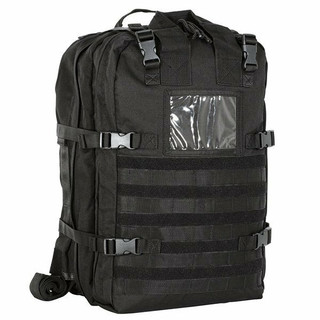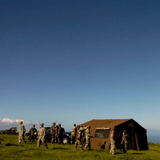The 5 Most Common Outdoor Injuries and How to Treat Them
The 5 Most Common Outdoor Injuries and How to Treat Them
Outdoor enthusiasts know that the thrill of the wilderness comes with its share of risks. While dramatic injuries such as from a bear mauling or lightning strike are incredibly unlikely, there is a high risk for certain injuries while outdoors.
These common outdoor injuries may seem minor. However, if you aren’t prepared, they can easily ruin your trip, or even escalate into something more serious. For example, a minor foot injury can slow down your pace. The slowed pace can mean you aren’t able to get off the trail before nightfall, causing you to spend an unplanned night in outdoors. This is why it is important that you always have well-packed first aid kit and know how to treat these most common outdoor injuries.
Shop outdoor first aid kits here.
1. Sprained Ankle
A sprain occurs when a ligament, the tissue connecting bones to each other, is stretched or torn. Sprained ankles are very common in the outdoors, such as when you slip on wet rocks or roll your ankle on uneven terrain. You’ll know you have a sprain from the pain and immediate swelling that occurs.
How to Treat a Sprain Outdoors
- Improvised Ice Pack: Sprains are typically treated by applying ice packs to the area for 15-20 minutes every hour. Since you probably don’t have ice packs in your first aid kit, try sticking your foot in an icy cold stream. Or have a friend dip a towel in the cold water. This helps reduce swelling and numb the pain.
- Compression: Use an elastic bandage, triangle bandage, or to wrap the sprained area. This helps control swelling. It shouldn’t be too tight, as it may restrict blood flow.
- Elevation: Prop up the injured ankle on a rock or gear to keep it elevated above heart level, which helps reduce swelling.
- Splint: If you have to hike out with a sprained ankle, apply a splint to immobilize the joint. You’ll also want to use improvised crutches. Or, at least use hiking poles while walking to reduce the amount of pressure you put on your ankle and help stabilize yourself as you hike.
- Pain Relief: OTC pain relievers such as ibuprofen or acetaminophen can help manage pain and inflammation.
2. Dehydration
It is easy to get dehydrated in the outdoors, especially when you didn’t bring enough water, or the water source you were relying on dried up. Mild dehydration will just make your mouth dry and cause fatigue. Serious dehydration can cause dizziness and confusion.
How to Treat Dehydration Outdoors
- Oral Rehydration Salts: Hopefully you packed oral rehydration salts in your first aid kit. These restore lost electrolytes quickly, allowing you to rehydrate much faster than with water alone.
- Add Salt and Sugar to Your Water: If you don’t have oral rehydration salts, you can improvise your own by adding sugar and salt to your water. The ideal ratio is 8 tsp of sugar and 1 tsp of salt per quart of water. If you don’t have this much sugar and salt with you, then add as much as you can. Even dumping the salty crumbs from your trail mix can help!
- Natural Electrolytes: Wild berries are a good natural source of electrolytes. If you are hardcore and know geology well, you can lick rock deposits for their natural salt content!
- Rest in the Shade with Feet Elevated: Find a shaded or cool area to rest with your feet propped up.
3. Cuts
No matter how careful you are when outdoors, some cuts and wounds are inevitable. They are particularly common if you use a knife which isn’t properly sharpened, improperly use an axe, or when wearing crampons in winter.
Regardless of whether the cut is minor or major, you will treat it the same way. However, if you are doing high-risk activities, you may want to pack an enhanced first aid kit with trauma items.
How to Treat Cuts Outdoors
- Apply Pressure: Use a clean cloth to apply firm pressure to the cut to stop bleeding. Keep the pressure steady for 10-15 minutes.
- Clean the Wound: Use purified water to rinse the cut and remove debris. If you have an irrigation syringe in your first aid kit, use this. If not, consider poking a hole in your water bottle lid so you can squeeze pressurized water onto the wound to clean debris from it. If it’s a serious wound that was bleeding profusely, you might not need to clean it at all since the blood flushed out debris.
- Antiseptic Application: If you have antiseptic ointment, apply it to the wound. If you didn’t pack this, cover the wound with skin balm or Vaseline instead. It won’t prevent infection, but will prevent the dressing from sticking to the wound.
- Consider Butterfly Bandages: If the cut is deep but straight (such as from a knife cut), use butterfly bandages to hold the edges of the cut together.
- Dress the Wound: Use a sterile dressing to cover the cut. If you don’t have a dressing, use the cleanest piece of fabric you have.
- Bandage: Tie or wrap a bandage around the dressing to hold it in place. Because the bandage isn’t in direct contact with the wound, it doesn’t have to be sterile like the dressing.
- Change Dressings: You will need to change the dressing once per day, or when it gets wet or saturated with blood. If you don’t have enough dressings in your first aid kit, improvise dressings by boiling strips of cloth and letting them dry. The cloth should be a smooth material. Cotton works well. Don’t use materials with lots of protruding fibers, such as wool.
4. Hypoglycemia
Regardless of whether you have diabetes or not, intense outdoor activity can cause your body to burn through glucose quickly and result in exercise-induced hypoglycemia—a condition where blood sugar levels drop too low. This can cause symptoms such as dizziness, fatigue, confusion, and even fainting.
How to Treat Hypoglycemia Outdoors
- Consume Fast-Acting Carbohydrates: If you experience symptoms of low blood sugar, eat or drink something high in sugar, such as energy bars or candy. Aim for about 15-20 grams of carbohydrates.
- Rest: Find a comfortable place to sit and relax while waiting for your blood sugar levels to stabilize. Avoid further strenuous activities until you feel better.
- Eat a Meal: Once you’ve managed your symptoms, consume a meal with both carbohydrates and protein to help maintain stable blood sugar levels.
5. Blisters
Blisters are by far one of the most common outdoor injuries. They occur when your shoes or gear rub your skin, causing friction. Blisters can be nasty enough to make it hard to walk, causing you to get stranded in the outdoors overnight.
How to Treat Blisters Outdoors
- Change Your Socks: Moisture softens your skin and makes it more prone to blisters. Put on dry socks to prevent foot blisters from getting worse.
- Create a “Doughnut” with Moleskin: Cut out a circle that is larger than the blister. Fold it in half and cut a hole in the middle. The hole should be just large enough for your blister to fit through. This “doughnut” will provide padding around the blister.
- Use Duct Tape on Heel Blisters: First put some gauze over the blister to prevent the duct tape from sticking to the blister directly. Then cover the entire heel area with a piece of duct tape. The duct tape is smooth, so it will prevent friction from your shoes rubbing on your heel as you walk.
- Don’t Pop the Blister: Popping blisters is a bad idea because it exposes the skin and opens it for an infection.
- If You Must Pop: Sometimes you have to pop a blister, such as if the blister is so large it is making it impossible to put your shoes back on. Always use a sterilized needle for popping blisters. After popping, dress and bandage it like you would a cut.













